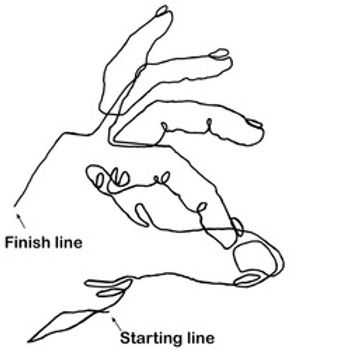DRAWING 101
Contour Drawing
Module 3 - Lecture
Kimon Nicolaides (1891-1938) is typically credited for popularizing this technique as he was an art instructor at the Art Students League of New York. His instruction utilized contour drawing as a way to initiate a drawing composition by outlining the form of the subject prior to adding depth. He published a book on his drawing techniques called “The Natural Way to Draw” that is still in publication to this day and renowned as an excellent guide to drawing.

In this piece, Nicolaides is using a modified contour technique to work out a study of the human form.
A student of Nicolaides went on to gain worldwide fame for his use of contour line drawings, Alexander Calder (1898 – 1976).

Calder took contour line use to a new frontier by transferring this drawing technique to wire sculpture art.

In the realm of contour drawing, precision is not the goal. Instead, it is about capturing the essence of the subject, embracing imperfections, and celebrating the spontaneity of the drawing process. Lines may waver, shapes may appear distorted, but therein lies the beauty of contour drawing—it is a direct expression of the artist's perception and interpretation.
There are a few variations of contour line drawing that an artist can use to approach their compositional subject. Let’s look at the various methods involved.
There is Blind Contour, Continuous Contour, Modified Contour, and Cross-Contour.
Blind Contour

Blind contour drawing' is when contour drawing is done without looking at the paper AT ALL.
This helps train you to look more often at your subject than look at your paper. Staring down at your paper while drawing can be a hard habit to break.
Watch this short video on Blind Contour Drawing.
Continuous Contour

Continuous line contour drawing is a contour drawing done without picking your pencil off of the paper. It is essentially done with one long line. Continuous line contour drawings can be done 100% "blind" or not.
Watch this short video on Continuous Contour Drawing.
Modified Contour

A "modified contour line drawing" allows you to look at your paper and pick up your pen, using multiple lines instead of one.
Although not completely blind, the artist should only look at the paper 10% of the time, and at the object 90% of the time. The artist only looks at the paper to place their pencil when they start a new line.
Contour drawings use no shading, but lighter and darker tonal areas can be "suggested" by varying line width and pressure. Darker, thicker lines can be used in shadow areas, and lighter, thinner lines in lighter areas.
Watch this short video on Modified Contour Drawing.
Cross Contour

Cross contour lines are drawn lines which travel, as the name suggests, across the form. Cross contours follow the form of the surface area- using curved lines over curving or spherical planes, straight lines across flat surfaces, etc.
Watch this short video on Cross-Contour.

